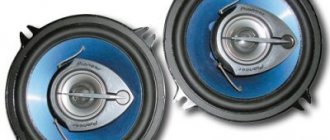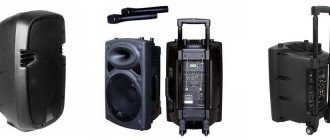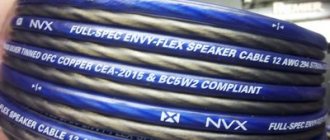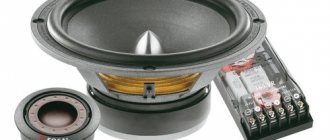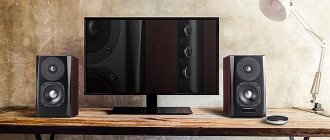On the modern market, acoustic systems are presented in a fairly large assortment. This equipment differs from each other in the scope of application (instrumental, concert, studio and others), according to technical characteristics, body shape and many other qualities.
The most important parameter to consider first is the number of “lanes” in the system. According to this criterion, one-, three- and two-way acoustics are distinguished. How they differ from each other and which system is better, we will try to answer in this article.
Sound frequency
The human hearing organs are capable of recognizing sounds with frequencies ranging from 20 to 20,000 Hz.
Therefore, the quality of music directly depends on the ability of the equipment to create clear sound waves in a given range. For this purpose, speakers began to be included in acoustic systems that reproduce exclusively low (20-150 Hz), medium (100-7000 Hz) and high (5-20 thousand Hz) frequencies. In this regard, the following appeared:
- Single-way systems, where the entire frequency range is produced by one speaker.
- Two-way acoustics, which have two speakers: one for playing music at medium and low frequencies, the second - only at high frequencies.
- Three-band equipment - a separate “column” is responsible for playing sounds in each range.
There is equipment with a large number of bands, where each speaker reproduces sound in a certain frequency range. The most popular are two- and three-way systems - they are the most affordable and provide excellent sound quality.
Appearance of crossover in speakers
A crossover is a special device that is used in speaker systems. It prepares the desired frequency limit for each audio speaker (speaker).
Advice : it’s good if, in addition to the crossover, the speakers have magnetic shielding, like the Edifier S330D. It eliminates interference, even if you place the speakers next to a monitor or TV.
If the frequency of the signal fed to the subwoofer is out of range, it may distort the audio signal. If the boundaries are violated by high frequencies, then, in addition to distorted sound, the user may have problems with the tweeter. Such high frequency pressure can simply damage the speaker.
That's what a crossover is for in speakers: it won't upset the balance. This element prevents the frequency signal from leaving the range.
Advantages of two-way acoustics
Two-way speaker systems are most popular among motorists.
They provide optimal sound quality at an affordable price. Due to the development of technology, two-way acoustics are actively being replaced by three-way equipment, but they are still common due to their advantages:
- Simple design for easy installation and configuration.
- High degree of coherence between speakers, resulting in improved sound quality.
- Maximum natural, “live” sound.
In two-way equipment there are only two speakers - LF and HF. The woofer reproduces sounds in the low and mid ranges, and the tweeter only reproduces sounds in the high range. Because of this, simple separation filters are required for the system to operate.
Features of three-way equipment
Three-way acoustics differ from the already described system in that they have better sound. The equipment in such systems is equipped with a midrange speaker, which carries so-called “spatial” information and creates surround sound. In addition, thanks to the separation of duties, the equipment has become more compact.
The negative quality of three-way systems is their high price. It is two to three times higher than that of two-way acoustics. Moreover, three-way acoustics implies the installation of crossovers - complex frequency filters. To set up such equipment, you must have excellent hearing, otherwise you will not be able to achieve consistency from the speakers.
Differences between speaker systems
Any speaker system consists of speakers (midrange, bass and tweeter), filtering equipment, signal amplifiers, audio cables and input terminals. Filtering devices are responsible for dividing the sound signal into several ranges. A two-band acoustics filter divides frequencies into two “sections” - up to 5-6 thousand Hz, and above 6 kHz. Three-way devices are usually equipped with crossovers - adjustable frequency filters that divide the sound range into three sections.
All acoustic equipment can be active or passive. In the first case, each speaker is equipped with a separate signal amplifier. This solution facilitates matching of emitters and reduces the overall cost of the system. However, at the same time, the complexity of maintenance, installation and initial configuration increases. Separate amplifiers most often complement a set of three-way devices.
Start
The first thing I did was dismantle the shelves. I removed the wooden pins and then assembled the box using glue and screws without one side wall. I covered the inside walls with 15 mm foam rubber and glued fluffy synthetic padding on top of the foam rubber. A block of wood was screwed into the middle of the side wall and glued to it in order to avoid cabinet resonances at high volumes. Under the midrange driver I attached a plastic basket with M440 bolts and put the side panel in place. All cases were covered with fiberboard and the ends were sanded. After 5 days, two buildings were ready to be covered with decorative film. Internal wiring for midrange and high frequency with a cross section of 1.5 square meters. mm for LF 2.5 sq.
Coaxial and component speakers
How three- or two-way acoustics in a car will sound largely depends on the type of speakers, which can be coaxial or component. The former are a single monolithic structure that combines high, medium and low frequency emitters. This solution makes the sound highly targeted. Therefore, such devices are used as a supplement and mainly in small cars.
Component speakers are emitters that can be placed in different places. Thanks to this, it is possible to achieve surround sound, but the process of installing equipment is complicated. Additionally, if installed incorrectly, the soundstage will be quite uneven. Component systems are installed in cars with a spacious interior.
Question of price
As noted earlier, two-way acoustics will cost much less than installing three-way equipment. This is due to two reasons:
- less equipment - only two speakers, a maximum of two amplifiers and one filter are required;
- simple installation - you can assemble such a system yourself, having basic knowledge in the field of electricity.
Three-way systems include more complex equipment, the cost of which is significantly higher than the price of conventional devices. In addition, if you decide to install such acoustics, you will have to seek the help of professionals - without special measuring devices and fine hearing, the installed system will sound the same as two-way acoustics. This is the main answer to the question of how two-way acoustics differ from three-way ones.
Adding a subwoofer
You can always add a subwoofer to the above types. In cases where it is necessary to create high sound pressure at the very bottom of the range, this is a very simple and very cheap solution
Especially when the quality of the bass is not particularly important (disco-explosions-gunshots)
Those who like to listen to music face the same inevitable problem. For a short time, you get the feeling that everything sounds very wonderful.
After which the understanding comes that something is not quite right, and the subwoofer needs to be moved or the knobs on it must be turned. But no matter how you move the subwoofer or turn the knobs on it, it will always turn out like this... If you can still get a good result on one track, then in the general layer of music there will be either a lot or a little of the subwoofer. And the soundtrack of each specific track will be transformed in a very specific way.
The reason is that the subwoofers' filters are very low in frequency. Usually this is an adjustable second order at 40-160 Hz and unregulated (it is always on) at 300-400 Hz. Coupled with the fact that the subwoofer speaker itself, as described above, rotates the phase in exactly this place:
It turns out that the concept of phase in a subwoofer essentially does not exist. As the total total phase shift in the operating frequency range of the subwoofer approaches the fifth order. A note just a tone higher and lower sounds completely different. With a very different phase - up to antiphase.... This is where the desire to continuously twist the knobs on the subwoofer from track to track comes from.
A lot of free time can be spent moving the sub around the room. I moved it a meter, and now it sounds completely different. The client sincerely thinks that by doing so he achieves a more even frequency response. But the problem is not at all in the frequency response, but in the fact that the subwoofer’s phase is screwed up to the point that it has no phase as such. You can rotate the phase on it. In all cases it will be bad. But it will be bad in different ways.
In practice, most music listeners stop listening to music with a subwoofer after just a couple of months. If we are talking about music.
And they turn it on only from time to time, to get a feeling of pressure.
Which is no longer particularly interesting after 20 times. And most music listeners try to get rid of a subwoofer. This is actually the reason for the large number of offers of subwoofers on Avito with an abnormally huge discount (for expensive models 3-6 times lower than the retail price).
And with the creation of pressure with subwoofers, everything is fine. Nobody argues with this.
These are actually all the options for the “sound characteristics” of acoustic systems with passive filtering.
Decide on the “character” of sound that you like best. Three-way, two-way and wideband acoustics are different acoustics. And it makes no sense to compare them with each other.
Once you understand what you want, consider options of different quality within this group.
The only choice you have is which distortions you find most disgusting. Phase or nonlinear. Or both, but little by little.
Read on topic:
